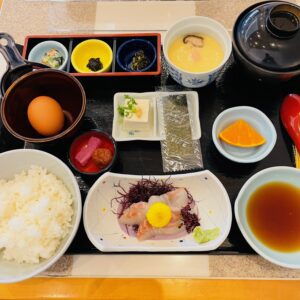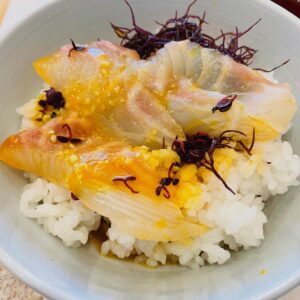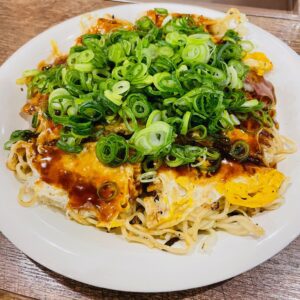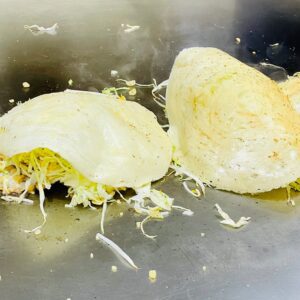April itinerary in Japan Day 3 (Ehime Meal edition)
(Wednesday, April 20)
Table of contents
1. JR Hotel Clement Uwajima “Sirene”
4. Yakiyaki Iron Plate Grill “Himawari Ichibancho Train Street Store”
1. JR Hotel Clement Uwajima “Sirene”
I had breakfast at the restaurant “Sirene” of “JR Hotel Clement Uwajima” which was near the hotel where I was staying on April 20th (Wednesday). We can eat Uwajima’s unique meals using local ingredients such as “Uwajima Tai-meshi”, “Kama-age shirasu (straight-from-the-pot young sardine which is freshly boiled) “, “Grilled dried local fish”, and “local vegetables” since the morning at “Sirene”. Even those people who are not staying at JR Hotel Clement Uwajima can have breakfast at “Sirene”.
I had “Tai-meshi Breakfast Set” (Yen 1,800 including tax) that I hadn’t eaten since I came to Uwajima. “Uwajima Tai-meshi” is the “100 selections of local cuisine” in Ehime prefecture selected by the Ministry of Agriculture, Forestry and Fisheries. “Uwajima Tai-meshi” is a dish of red sea bream sashimi caught in the Uwa Sea, mixed with soy sauce, raw eggs, seaweed, etc. over rice. Simply put, it is a raw egg over rice with sashimi of red sea bream and seaweed. I think “Uwajima Tai-meshi” is a nationally famous local dish.

It is said that “Uwajima Tai-meshi” originated from the Iyo Suigun (navy) of the Uwa Sea, who mixed rice in a bowl with soy sauce and sashimi.
On the other hand, “Tai-meshi” in Matsuyama City, Ehime Prefecture is a rice cooked with grilled sea bream. I prefer sashimi of red sea bream, so I prefer “Uwajima Tai-meshi” to “Matsuyama Tai-meshi”.
There are very few cities where we can eat local food for breakfast, so it would be very helpful for travelers to have a restaurant that serves local food for breakfast like Uwajima. If there are more restaurants in cities other than Uwajima where you can eat local food in the morning, I think it will be good for more people to eat local food and attract tourists.
The “Tai-meshi breakfast set” of “Sirene” was very delicious and I ate it in no time. It was a very happy morning to be able to eat delicious local food.

2. Local cuisine “Hozumi-tei”
After enjoying a two-hour sightseeing tour of Uwajima on a rental cycle, I had lunch at “Local cuisine Hozumi-tei“. The supper the day before at Hozumi-tei was very delicious, so I revisited to eat “Uwajima Tai-meshi” at “Hozumi-tei”. “Hozumi-tei” is one of the 100 famous tabelog restaurants.
I ordered “Tai-meshi / Satsuma-meshi Yokubari (greedy) Set” (Yen 1,650 including tax) and “Fukumen” (Yen 715 including tax) at “Hozumi-tei”. “Tai-meshi / Satsuma Yokubari (greedy) Set” is a set of “Uwajima Tai-meshi” and “Satsuma-meshi”. It comes with two rice bowls and a wooden container for cooked rice, so you can enjoy “Uwajima Tai-meshi” and “Satsuma-meshi”, which have completely different tastes.

“Satsuma-meshi” is a local dish of barley miso, soup stock, and roasted fish mixed in a earthenware mortar and sprinkled over rice or barley rice.
The wife of the owner of “Hozumi-tei” told me at dinner the day before that “Satsuma-meshi” was often eaten for dinner at homes in Uwajima in the past. “Satsuma-meshi” is more like the taste of Mom’s cooking than “Uwajima Tai-meshi” in Uwajima. It is also introduced by the Ministry of Agriculture, Forestry and Fisheries in “Our Regional Cuisines” in Ehime Prefecture.
“Satsuma-meshi” originated from being eaten by fishermen on a boat. It is also called “Iyo Satsuma”. There are various theories about the origin of the name “Satsuma”, such as the theory that it came from Satsuma Province (Kagoshima Prefecture) and the theory that the husband helps his wife, that is, “Satsuma”, which means to assist his wife. The wife of the owner of “Hozumi-tei” said that “Satsuma” came from the means to lighten the burden on women’s housework because it is a simple dish.
“Uwajima Tai-meshi” from “Hozumi-tei” was very delicious. However, the taste of the sauce seemed to be stronger than that of “Uwajima Tai-meshi” of “Sirene”. In any case, “Uwajima Tai-meshi” is a dish of red sea bream sashimi mixed with soy sauce, raw eggs, and seaweed, so I don’t think there is a big difference in taste.

On the other hand, “Satsuma-meshi” had a strong impact on the taste and aroma. “Satsuma-meshi” was a delicious dish that seemed to be addictive, contrary to its plain appearance. Whenever I visit Uwajima again, I definitely want to eat “Satsuma-meshi”.

“Fukumen” is also a local dish of Uwajima. It is also introduced as a dish around Uwajima City in “Our Regional Cuisines” by the Ministry of Agriculture, Forestry and Fisheries. “Fukumen” is made by laying boiled flaked fish, pink soboro (powdered fish), green onions, etc. on the konjac noodles. It is eaten as a celebrative dish for festivals, New Year, wedding receptions and longevity celebrations.
“Fukumen” had a rather simple taste, unlike the gorgeous appearance. It can be said that it is the opposite of “Satsuma-meshi”, which looks sober but has a strong taste impact.

3. Izakaya “Oiri-tei”
After arriving in Matsuyama City, I had dinner at the izakaya “Oiri-tei” near the downtown Okaido. I ate “sashimi platter”, “grilled eggplant”, “Noresore (juvenile conger)”, and “squid sashimi and natto” at “Oiri-tei”. “Oiri-tei” is a small izakaya run by a couple.
“Assorted sashimi” includes red sea bream, “Hogo (scorpion fish)”, bonito, striped jack, chicken grunt, flathead, Redspotted Grouper, Spotted halibut, Japanese common squid (Pacific flying squid), vermiculated puffer, great amberjack, and halfbeak. The great kindness about “Oiri-tei” is that the type of fish in the “sashimi platter” is handwritten on paper according to the position on the plate. Therefore, I was able to post such many types of fish on our blog.

All the fish in the “sashimi platter” were from Ehime prefecture. All kinds of sashimi were really delicious. Especially, the ones that were touchingly delicious were the flathead and vermiculated puffer. Most of the “Oiri-tei” were local customers, but they all said that the sashimi of “Oi-tei” was the most delicious in Matsuyama. I was also very satisfied.
“Hogo” is a scorpion fish, a dialect of Matsuyama City. By the way, it is said that scorpion fish is called “Mahogo” in Uwajima city.
Vermiculated puffer is a member of the globefish department tiger puffer genus and is a medium-sized puffer with a total length of about 35 cm. Since it is cheaper than tiger puffer and purple puffer, it seems that vermiculated puffer is popular as a commoner’s blowfish. However, for me, the sashimi of vermiculated puffer I ate that day was the best.
“Akou” is a Redspotted Grouper. “Kurushima Strait Akou (Redspotted Grouper)” (season: July-September) is “PRIDE FISH” in Ehime prefecture selected by Japan Fisheries Co-operative. The Kurushima Strait is a strait located in Imabari City, Ehime Prefecture. The Kurushima Strait is a great fishing ground blessed with fast currents and abundant plankton. The taste of summer “Akou” seems to be exquisite, so I definitely want to eat “Kurushima Strait Akou” in the summer.


“Grilled eggplant” and “squid sashimi and natto” were also delicious, but they were not particularly noteworthy because they are common dishes. “Noresore”, a juvenile conger, was in the final stage of the season and grew up big. It is the longest “Noresore” I have ever eaten with a total length of about 10 cm. I love the way “Noresore” slide down my throat like somen noodle.

4. Yakiyaki Iron Plate Grill “Himawari Ichibancho Train Street Store”
I didn’t eat rice at “Oiri-tei”, so I ate “Original Mitsuhama-yaki” at Yakiyaki Iron Plate Grill “Himawari Ichibancho Train Street Store” and drank “Mitsuhama Minato Highball”.

“Mitsuhama-yaki” is an okonomiyaki that is eaten around the former Mitsuhama-cho in the western part of Matsuyama city. Mitsuhama’s comfort food. In the Taisho era, wheat flour melted in water was baked, green onions were put on it, and the sauce was sprinkled on it. This “Issen Yoshoku (Cheap western food)” is said to be the origin of “Mitsuhama-yaki”. Unlike Hiroshima-style okonomiyaki, “Mitsuhama-yaki” is folded in half.

“Hiroshima-style okonomiyaki”, which has a similar shape, is also based on “Issen-yoshoku,” which was originally a snack for children. It is said that Isao Ise of “Micchan” and Zenjiro Nakamura of “Zensan” are the originators of Hiroshima-style okonomiyaki. they opened okonomiyaki shops in the street stalls built around 1950 after World War II. The picture below is the Hiroshima-style okonomiyaki of “Micchan Sohonten” that I ate in March 2022.

The biggest difference between “Mitsuhama Yaki” and “Hiroshima-style okonomiyaki” is how to make it. At Mitsuhama, the dough is baked on an iron plate and seasoned noodles are placed on it. On the other hand, in Hiroshima, it is common to put cabbage and ingredients on the dough, and then cover the dough and ingredients on the noodles. The first photo below is “Mitsuhama-yaki” and the second is “Hiroshima-style okonomiyaki”.


The “Original Mitsuhama Yaki” of “Yakiyaki Iron Plate Grill Himawari” was as delicious as the popular store “Micchan Sohonten” in Hiroshima. I have traveled to Matsuyama City several times, but this time I ate “Mitsuhama Yaki” for the first time. I regret not having eaten until now. From now on, when I go to Matsuyama, I will definitely eat “Mitsuhama Yaki”. “Hiroshima-style okonomiyaki” is famous all over the country, but I think “Mitsuhama-yaki” should be more famous. By all means, I want many people to eat “Mitsuhama Yaki”.
Note: The departure / arrival times, fares of transportation, admission fees, meal fees, etc. listed in the text are as of the time of writing the BLOG. Please check for yourself when you go on a trip as it may change in the future.